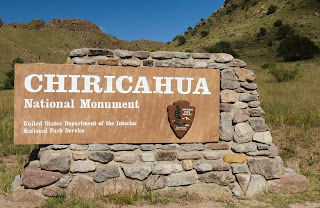After a beautiful drive on scenic highways, driving through grassy valleys surrounded by mountains, cloud shadows changing the view every few minutes, we arrived at Chiricahua, the Land of Standing Rocks, in mid-afternoon. We stopped at the visitor center, talked with the volunteer manning the desk, and watched the movie. There is a scenic drive to the top of the mountain area. These mountains are considered a "sky island", which refers to an isolated mountain range surrounded by grassland sea. The landscape changes as the elevation increases, going from meadows with cacti and mesquite, to oaks and juniper, than with cypress, pine and the woodlands seen at higher elevations- 9763 feet. Because of its isolation and drastic change in topography, plants and animals from four different ecosystems meet here. There are many different birds, including Mexican species at the northern end of their range. We spotted a couple as soon as we started the drive- a Mexican Jay and an Acorn Woodpecker. I managed to get a shot of the Jay. An animal I would have loved to spot- but is apparently seen only rarely- is the coatimundi, a member of the raccoon family. Chiricahua fox squirrels are seen only here. We did not spot one of those, either.
As we drove further up the mountain, the "standing rocks" for which this park is known, became visible. They could be seen towering over the roads, different shapes tempting you to name them. Once we reached the top, we walked down to an amphitheater-like valley just filled with the standing rocks. It reminded me of the Chinese soldiers that toured the country several years ago. The rocks themselves were formed from volcanic activity, and the volcano can still be seen in the distance.
Returning to the bottom of the mountain, we stopped to see the old Faraway Ranch. Swedish immigrants, the Eriksons, settled here in 1888, building a cabin. Their daughter and her husband turned the homestead into a guest ranch. They took guests on horseback tours of their "back yard", showing them the unusual rock formations in the area. This remained a guest ranch for tourists, bird watchers and hikers up until 1973. After the deaths of all three of the original homesteaders children, the ranch and furnishings became a historic district within the park.
Leaving as the sun was beginning to set, we headed to Willcox, where we had booked a hotel room. It had rained very hard in the area the day before, and we noted a number of areas with shallow water- some with ducks! It is funny, after driving in the desert for so many miles, how the sight of even very shallow water attracts your attention!










No comments:
Post a Comment